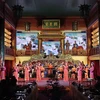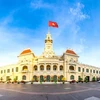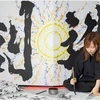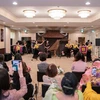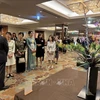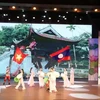A group of Ma ethnic women in the Central Highlands province of Dak Nong are sparing no efforts to pass down their traditional brocade weaving skills to descendants in the hope that this traditional profession will live on.
H’khieu, a woman from Quang Khe commune in Dak G’long district is celebrated for her talent and passion in creating brocade items. She is now responsible for teaching local villagers weaving techniques as a means to serve their own family life and increase their income.
Another woman from Dac Nia commune, Gia Nghia town called H’Bach confided that nowadays very few youngsters are enthusiastic about the craft. Hence, local artisans are doing all they can to hand down their knitting experiences to children in families and hamlets.
Vice Chairman of Quang Khe commune, K’Sieng, boasted that though brocade weaving is not as popular as it used to be, many families in the region still persist in keeping their traditional weaving looms in a bid to maintain the industry.
Local authorities have helped villagers raise their keen awareness of reviving their ethnic cultural quintessences so that they will not disappear, K’Sieng said.
The Ma ethnic people are known by other names like Chau Ma, Cho Ma and Che Ma. They live in their own villages called “bon” in Bao Loc, Di Linh and Da Te plateaus in the Central Highlands, and in the southern province of Dong Nai . There are around five to ten stilt houses in each “bon”.
The Ma people have two kinds of family relations, including a large patriarchal family and a small patriarchal family. The oldest person of the highest generation in the family will run all of the household’s business and take care of valuable possessions such as gongs and jars.
They believe in God (Yang), and worship many others like “Yang Hiu” (House God), “Yang Koi” (Rice God) and “Yang Bonom” (Mountain God). They often sacrifice animals to these Gods on the occasion of a good harvest, giving birth, or when someone is ill or dies.
The Ma people do not have a writing system. Their folk stories are passed down orally from generation to generation, encompassing legends, fairy tales and folk songs.
Ma youngsters like to wear many copper bracelets with engraved signs of different sacrificial rituals to pray for good luck.-VNA
H’khieu, a woman from Quang Khe commune in Dak G’long district is celebrated for her talent and passion in creating brocade items. She is now responsible for teaching local villagers weaving techniques as a means to serve their own family life and increase their income.
Another woman from Dac Nia commune, Gia Nghia town called H’Bach confided that nowadays very few youngsters are enthusiastic about the craft. Hence, local artisans are doing all they can to hand down their knitting experiences to children in families and hamlets.
Vice Chairman of Quang Khe commune, K’Sieng, boasted that though brocade weaving is not as popular as it used to be, many families in the region still persist in keeping their traditional weaving looms in a bid to maintain the industry.
Local authorities have helped villagers raise their keen awareness of reviving their ethnic cultural quintessences so that they will not disappear, K’Sieng said.
The Ma ethnic people are known by other names like Chau Ma, Cho Ma and Che Ma. They live in their own villages called “bon” in Bao Loc, Di Linh and Da Te plateaus in the Central Highlands, and in the southern province of Dong Nai . There are around five to ten stilt houses in each “bon”.
The Ma people have two kinds of family relations, including a large patriarchal family and a small patriarchal family. The oldest person of the highest generation in the family will run all of the household’s business and take care of valuable possessions such as gongs and jars.
They believe in God (Yang), and worship many others like “Yang Hiu” (House God), “Yang Koi” (Rice God) and “Yang Bonom” (Mountain God). They often sacrifice animals to these Gods on the occasion of a good harvest, giving birth, or when someone is ill or dies.
The Ma people do not have a writing system. Their folk stories are passed down orally from generation to generation, encompassing legends, fairy tales and folk songs.
Ma youngsters like to wear many copper bracelets with engraved signs of different sacrificial rituals to pray for good luck.-VNA




